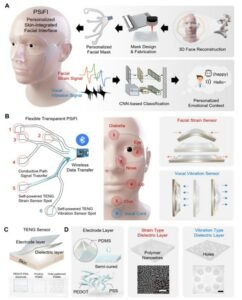South Korean scientists have created a wearable device capable of recognizing and translating human emotions. Both stretchable and transparent, the device is powered by a triboelectric effect, meaning it is self-powered by the wearer. It is also equipped with a wireless interface to communicate its analysis to an external system.
While the device is not yet commercially available, its inventors say it could help translate emotions for the disabled. In a future iteration, the device could also perform duties as a “digital concierge” that is programmed to respond to different emotional states.
Building a Device to Translate Muman Emotions
To create their mood-deciphering system, Professor Jiyun Kim and his research team in the Department of Material Science and Engineering at South Korea’s Ulsan National Institute of Science and Technology (UNIST) assembled a unique mask they call a personalized skin-integrated facial interface (PSiFI).
According to the press release announcing the system, this potentially groundbreaking device “features a first-of-its-kind bidirectional triboelectric strain and vibration sensor that enables the simultaneous sensing and integration of verbal and non-verbal expression data.” In short, sensors placed at critical locations throughout the transparent PSiFI allow the device to capture minute movements and vocalizations. Once these minute movements are captured, the device uses a fully integrated data processing circuit that can wirelessly transfer its readings to an external device for analysis.
“Based on these technologies, we have developed a skin-integrated face interface (PSiFI) system that can be customized for individuals,” Kim explained.


Next, the team applied machine learning algorithms to decipher what emotions underlie the combination of facial movements and reactions captured by the interface. They note that this process was much more straightforward than expected, resulting in a highly effective mood-translation device that can accurately decipher human emotions. In fact, the researchers say their system can be quickly adapted to a specific individual and trained in a few short sessions to read their emotional state accurately.
“With this developed system, it is possible to implement real-time emotion recognition with just a few learning steps and without complex measurement equipment,” explained Jin Pyo Lee, the study’s first author. “This opens up possibilities for portable emotion recognition devices and next-generation emotion-based digital platform services in the future.”
Human Emotions Translator Could Enable Digital Services in a VR Environment
Following numerous successful sessions with their wearable system in the lab environment, the team decided to display its success in a potentially commercial setting. According to the release, “the team applied the system to VR environments, utilizing it as a “digital concierge” for various settings, including smart homes, private movie theaters, and smart offices.” As expected, the system accurately deciphered individual emotions and then presented virtual options based on those emotions, including products and services.
“The system’s ability to identify individual emotions in different situations enables the provision of personalized recommendations for music, movies, and books,” the system’s inventors explain.
As noted, the device itself in not yet commercially available, However, the research team behind its development believe system’s like theirs will be crucial in the emerging data-driven environment of the future.
“For effective interaction between humans and machines, human-machine interface (HMI) devices must be capable of collecting diverse data types and handling complex integrated information,” said Kim. “This study exemplifies the potential of using emotions, which are complex forms of human information, in next-generation wearable systems.”
Christopher Plain is a Science Fiction and Fantasy novelist and Head Science Writer at The Debrief. Follow and connect with him on X, learn about his books at plainfiction.com, or email him directly at christopher@thedebrief.org.

